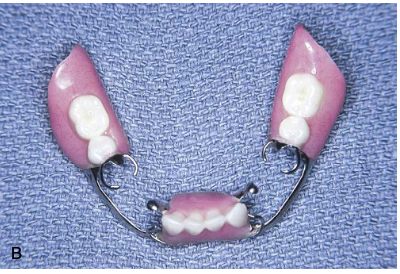CHAPTER 5: MANDIBULAR MAJOR CONNECTORS
1/57
There's no tags or description
Looks like no tags are added yet.
Name | Mastery | Learn | Test | Matching | Spaced |
|---|
No study sessions yet.
58 Terms
components of a typical removable partial denture
rests
direct retainers
major connectors
minor connectors
one or more bases
indirect retainers (if the prosthesis has distal extension bases)
stabilizing / reciprocal components (as parts of a clasp assembly)
when a prosthesis that can be removed from the mouth is used
prosthesis should extend to both sides of the arch for optimal stability
cross-arch tooth contact at a distance from functional force achieves optimal resistance
transfer of functional forces of occlusion from denture base to supporting teeth and tissues is crucial
rigid major connector is most effective in joining the function-receiving prosthesis to selected arch regions
major connector
designated for proper shape, thickness, and location
ensures unified and effective partial denture components
comparable to the frame of an automobile or the foundation of a building
provides cross-arch stability to resist displacement by functional stresses
connects prosthesis parts on one side of the arch with those on the opposite side
margins adjacent to gingival tissue should be far enough from tissue to avoid impingement
minimum of 4mm below the gingival margin
recommended location of the superior border of a lingual bar connector
—the limiting factor is the height of the moving tissue in the floor of the mouth
maxillary arch
the borders of the major connector may be placed well away from gingival tissue in this arch because no moving tissue is present in the palate as in the floor of the mouth
2 reasons why palate is well suited for placement of the connector
an adequate deep blood supply
presence of firm submucosal connective tissue
—however, when soft tissue covering the midline of the palate is less displaceable than the tissue covering the residual ridge, varying amounts of relief under the connectors must be provided to avoid impingement of tissue
chief functions of a major connector
minimization of torque to individual teeth
unification of the major parts of the prosthesis
distribution of the applied force throughout the arch to selected teeth and tissue
cross-arch stability
effectively distributes forces throughout the arch
the principle of leverage is connected with this component part
it limits movement possibilities by acting as a counteracting lever
acts to reduce the load to any one area while effectively controlling prosthesis movement
becomes more important in situations associated with high potential for greater prosthesis movement (e.g., distal extensions)
consequences of a flexible connector
detrimental to the comfort of the patient
jeopardizes the supporting oral structures
manifestation of a failure major connector to provide rigidity
injury to residual ridges
impingement of underlying tissue
traumatic damage to periodontal support of the abutment teeth
guidelines for the location & design of major connectors
should be free of movable tissue
impingement of gingival tissue should be avoided
bony and soft tissue prominences should be avoided during placement and removal
should be located and relieved to prevent impingement of tissue that occurs because the distal extension denture rotates in function
relief should be provided beneath a major connector to prevent its settling into areas of possible interference, such as inoperable tori or elevated median palatal sutures
directly proportional
the amount of relief required is __ to the difference in displaceability of the tissue covering the midline of the palate and the tissue covering the residual ridges
gingival tissue
must have an unrestricted superficial blood supply to remain healthy
2 ways to ensure maximum freedom for gingival tissue
palatal major connector should be placed a minimum of 6mm away from and parallel to the gingival margins
minor connectors that must cross gingival tissue should do so abruptly, joining the major connector at nearly a right angle
areas where palatal connectors require no relief
palatal torus
prominent median palatal suture area
intimate contact between the connector & the supporting tissue
this contact adds much to the support, stability, and retention of the denture
—except for gingival areas, intimacy of contact elsewhere in the palate is not detrimental to the health of the tissue if rests are provided on abutment teeth to prevent tissue-ward movement
anterior palatal strap
there will be irregular in outline as they follow the contours between the rugae
should be located as far as possible posteriorly to avoid interference with the tongue in the area of the rugae
should be uniformly thin and its anterior border should be located to follow the contours between the crests of the rugae
a useful rule applied to MC and throughout partial denture design
to try to avoid adding any part of the denture framework to an already convex surface
characteristics of MC contributing to health & well-being
contribute to prosthesis support
cover no more tissue than necessary
do not interfere with or irritation to the tongue
made from an alloy compatible with oral tissue
do not alter the natural contour of the lingual surface
do not contribute to food particle retention or trapping
provide cross-arch stability through broad stress distribution
have support from other framework elements to minimize rotation tendencies
do not impinge on oral tissue during restoration placement, removal, or rotation
6 types of mandibular major connectors
labial bar
lingual bar
linguoplate
sublingual bar
cingulum bar (continuous bar)
lingual bar with cingulum bar
lingual bar
additional bulk may be needed for rigidity
inferior border slightly rounded to prevent lingual tissue impingement
made of reinforced, 6-gauge, half-pear–shaped wax or similar plastic pattern
half-pear shape connector located above moving tissue but below gingival tissue
farther inferior border from adjacent teeth reduces impingement on gingival tissue
superior border tapered towards gingival tissue, with greatest bulk at inferior border
inferior border located as far as possible to avoid tongue interference and food trapping
lingual bar with cingulum bar
considered when a linguoplate is the major connector of choice but the axial alignment of the anterior teeth is such that excessive blockout of interproximal undercuts must be made
linguoplate
sublingual bar
cingulum bar
these major connectors are preferred if less than 8 mm exists between gingival margins and the movable floor of the mouth
relief
provided for soft tissue under all portions of the mandibular major connector and at any location where the framework crosses the marginal gingiva
superior border of a lingual bar connector
should be tapered toward the gingival tissue superiorly, with its greatest bulk at the inferior border, resulting in a contour that has a half-pear shape
inferior border of the lingual bar
framework should be slightly rounded when polished
round border prevents impingement on lingual tissue during inferior denture rotation
bar should be positioned to avoid impingement on mouth floor tissue during normal activities
lowering lingual bar distance from adjacent teeth's lingual gingival crevices helps avoid impingement
In addition, the more inferiorly a lingual bar can be located, the farther the superior border of the bar can be placed from the lingual gingival crevices of adjacent teeth, thereby avoiding impingement on the gingival tissue
2 clinically acceptable methods used to determine mouth floor height
measurement of mouth floor height using periodontal probe
less variable and more clinically acceptable
patient's tongue tip lightly touches upper lip vermilion border
records allow transfer to diagnostic and master casts.
ensuring a rather advantageous location of the inferior border of the major connector
use of individualized impression tray with lingual borders 3mm short of elevated floor
use of impression material for accurate molding as patient licks lips
individualized / custom tray
may be used for the same purpose if a stock tray causes impingement on this functional position
linguoplate
should not serve as indirect retainers; definite rests must be provided
the upper border should follow the natural curve of the supracingular surfaces of the teeth
results from a rectangular space bounded by the lingual bar, anterior tooth contacts, and the cingula
should be thin and contoured to follow the contours of the teeth and embrasures; should not be above the middle third of the lingual surface
all gingival crevices and deep embrasures should be blocked out parallel to the placement path to avoid gingival irritation and wedging effect between the teeth
linguoplate & cingulum bar
these connectors ideally should have a terminal rest at each end, regardless of the need for indirect retention
upper border of linguoplate
should follow the natural curvature of the supracingular surfaces of the teeth
should not be located above the middle third of the lingual surface, except to cover interproximal spaces to the contact points.
apron of linguoplate
closely adapted to the teeth extending into non-undercut interproximal embrasures, resulting in a scalloped form
this form benefits from some anterior teeth acting together to help resist horizontal rotational tendencies of the prosthesis, especially if the posterior ridge form does not resist such movement
uses of apron
to cover areas that would be irritating to the tongue
to avoid gingival irritation / entrapment of food debris
indication of linguoplate
class I situations
high lingual frenum
limited space for a lingual bar
future replacement of incisor teeth
stabilizing periodontally weakened teeth
steps in designing mn major connectors
outline the basal seat areas on the diagnostic cast
outline the inferior border of the major connector
outline the superior border of the major connector
connect the basal seat area to the inferior and superior borders of the major connector
add minor connectors to retain the acrylic resin denture base material
sublingual bar
similar to lingual bar, but more inferior and posterior
can be used in lieu of lingual plate if lingual frenum doesn't interfere or in presence of an anterior lingual undercut
used when mouth floor height doesn't allow superior border placement at least 4mm below the free gingival margin
contraindications of sublingual bar
interfering lingual tori
high attachment of a lingual frenum
interference with elevation of the floor of the mouth during functional movements
cingulum bar (continuous bar)
can be added to lingual bar or used independently
located on or slightly above the cingula of the anterior teeth
may be more esthetically acceptable than a linguoplate when wide diastemata exist between the lower anterior teeth
suitable for linguoplate connectors where axial alignment of anterior teeth requires excessive blockout of interproximal undercuts
labial bar
lingually inclined teeth may need crowns reshaping
if a mandibular torus interferes with lingual bar placement, it should be removed unless surgery is contraindicated
used when extreme lingual inclination of lower premolar and inferior teeth rarely prevents the use of a lingual bar major connector
swing-lock design
connected by hinge and latch
consists of labial bar connected to major connector
incorporated with hinged continuous labial bar concept
can be used to ensure that all remaining teeth share in stabilization and retention of the prosthesis
indications of swing-lock design
missing key abutments — can be used when all remaining teeth are used for retention and stability
unfavorable soft tissue contours — the hinged continuous labial bar concept can accommodate these contours
teeth with questionable prognoses — the loss of a tooth would not compromise retention and stability to such a degree
unfavorable tooth contours — can be used when existing tooth contours or excessive labial inclinations prevent conventional clasp designs
contraindications of hinged labial bar concept
presence of a shallow buccal or labial vestibule or a high frenal attachment
poor oral hygiene or lack of motivation for plaque control by the patient — most obvious
—any of these factors would prevent the proper placement of components of the Swing-Lock partial denture
support
provided by multiple rests on the remaining natural teeth
gained by:
using rests
well-fitting denture bases
minor connectors arising from the labial bar
stabilization / reciprocation
supplemented by the labial bar with its retentive struts
provided by a linguoplate that contacts the remaining teeth
retention
obtained on terminal abutments
provided by a bar type of retentive clasp with arms projecting from the labial or buccal bar and contacting the infrabulge areas on the labial surfaces of the teeth.
linguoplate pattern
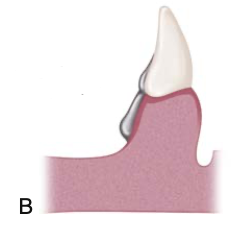
continuous (cingulum) pattern
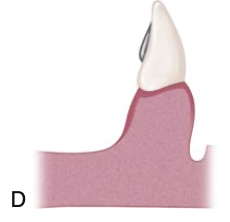
sublingual bar pattern
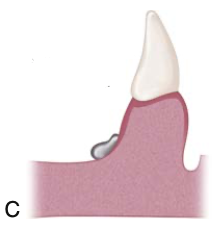
lingual bar major connector [illustration]

palatal major connector [illustration]
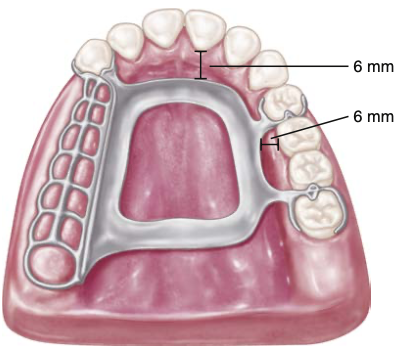
sublingual bar major connector [illustration]
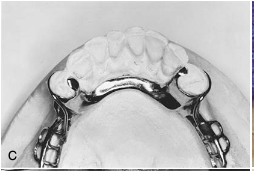
metal lingual bar major connector [illustration]
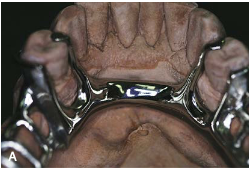
linguoplate major connector [illustration]
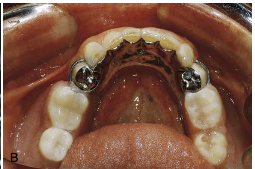
lingual bar with cingulum bar [illustration]
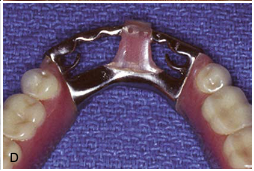
cingulum bar major connector [illustration]
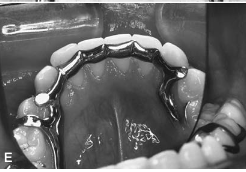
labial bar major connector [illustration]
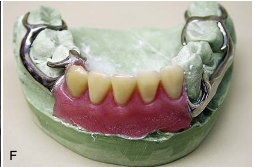
single palatal bar
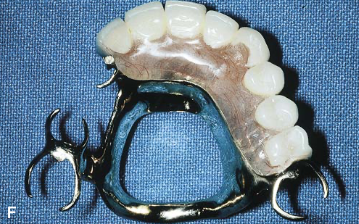
labial bar major connector class III mod 1 [illustration]
